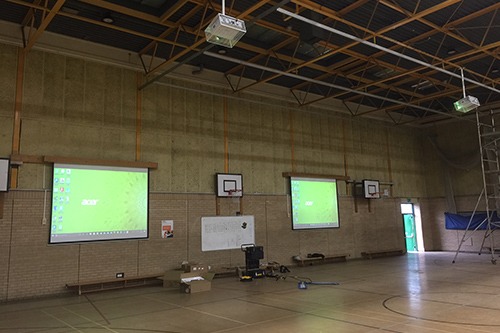Sports halls are some of the most challenging places to install audiovisual systems because they are large and open with a high roof.
Because of this, the design of sports hall audiovisual systems presents a few challenges, including where power will come from, how to hide cables, safety, and screen, projector and speaker locations to deliver an optimal experience.
Due to the nature of how sports halls are used, audio visual systems must be robust and accommodate all types of viewer. This requires a good screen and speaker placement so that everyone in the hall can see and hear what’s on.
Projectors
The great thing about projectors is they can be installed from any sound roof girder. It doesn’t necessarily matter where the girder is because projectors are available to accommodate different throws (the distance from the lens to the screen surface). For example, an ultra-short-throw projector displays an image 0 to 4 feet away from projector to screen, while a short-throw projector does it in 3 to 8 feet.
Ultra-short throw projectors can also be installed on walls with the lens facing a screen less than 1 foot away. This is great when roof installation isn’t possible.
Irrespective of installation type, projectors should always be encased in a mesh cage to protect them from ball games. This will not only protect the projector but also ensure safety for people on the ground (the projector won’t be able to fall).
Projector screens
Projector screens can be installed as a single sheet or as a roll-up screen. Roll-up screens tend to be more popular for sports halls because they take up less wall space when not in use. They also offer adjustable lengths for different media.
You can also get electric projector screens where you can lower and raise the screen remotely. This makes life easier (just press a button), but these screens are more expensive, and they introduce mechanical parts which could wear down.
Projector screens are available in 4:3, 16:10, 1:1 and 16:9 aspect ratios. The most popular format in sports halls is 4:3. 16:10 is best for movies and video demos. 1:1 is a square, so it can be useful for projecting documents and photos.
Televisions / displays
Televisions can be installed in sports halls, but they need to be encased in metal mesh cages. They are a good choice for playing video loops, demos and other content, as well as playing news and music TV channels.
The limitation to televisions is size. Whereas projector screens are available in sizes wider than 4.88m (191”) TVs top out at around 75”.
Large digital interactive displays may be a better option than TVs if you want to give people the option to interact with content. These have touchscreen functionality and run software with apps – ideal for interactive lessons and tests in sports halls.
Speakers
Should you dot lots of small speakers around your sports hall? Should you have a surround sound system or 2 powerful speakers? Should your speakers be wired or wireless? These are all good questions when it comes to sports hall speakers.
The correct speaker system depends on what the system is for. If it’s for use when your sports hall is packed, a surround sound system will be best. If it’s for small presentations, a small front-facing 2:1 speaker system will work just fine.
Multi-speaker systems work better than central speaker systems in sports halls because they fill the room equally. However, you need very tight dispersion. If you can’t achieve this, a centre cluster approach will work very well.
Get expert audiovisual advice
We specialise in fitting out sports halls with audiovisual systems. Get expert advice today by calling 01924 423 111 or email us at info@kpms.co.uk.



